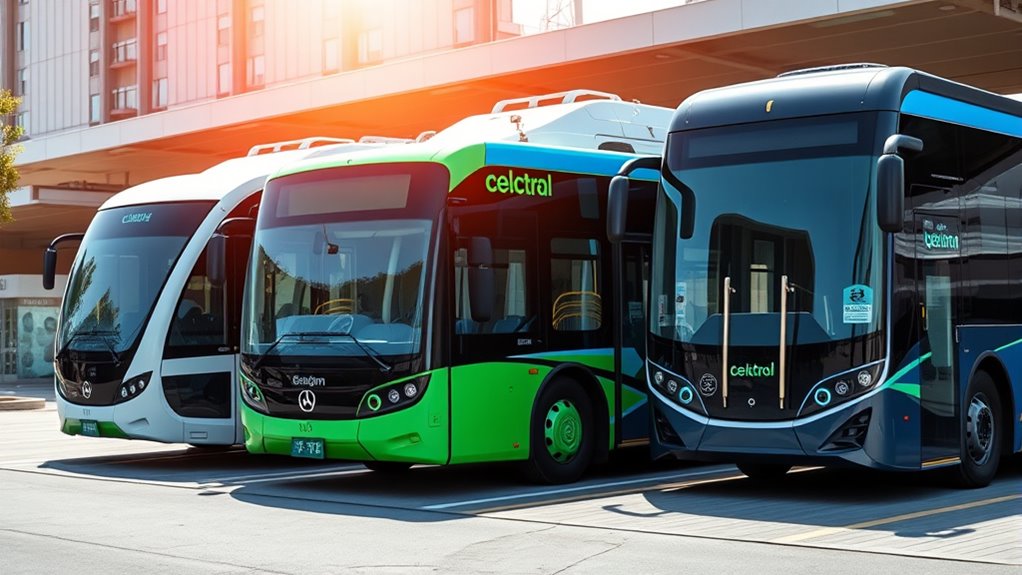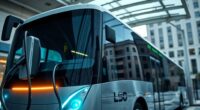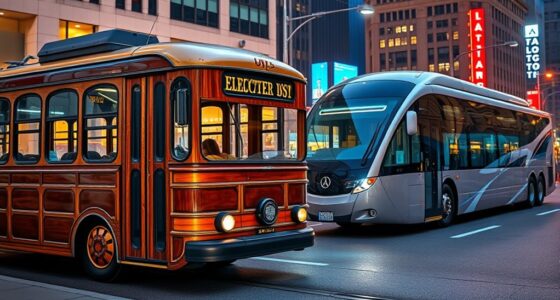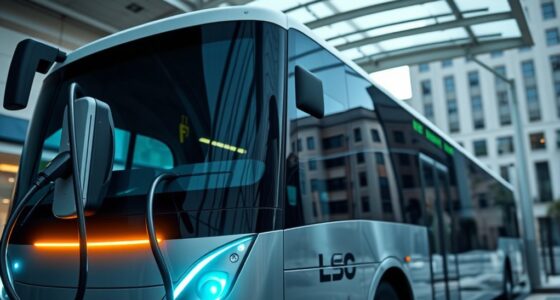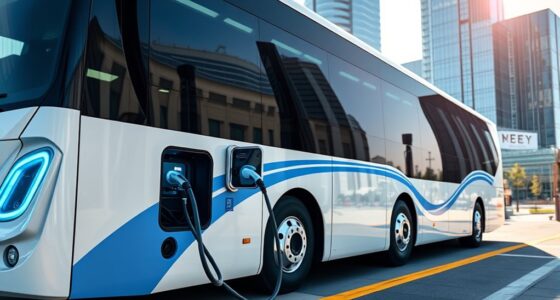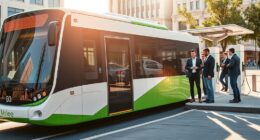Understanding the different types of electric buses helps you see how they’re reducing emissions and improving city transit. Battery-electric buses run solely on rechargeable batteries, offering quiet operation and no emissions, perfect for urban routes. Plug-in hybrid buses combine batteries with a small engine, switching modes for flexibility. Fuel cell buses use hydrogen to generate electricity, providing longer range and fast refueling. Exploring these options reveals a range of eco-friendly solutions shaping smarter, cleaner transportation systems.
Key Takeaways
- Battery-electric buses run solely on rechargeable batteries, ideal for urban routes with zero emissions.
- Plug-in hybrid buses combine batteries with a small engine, switching modes for route flexibility.
- Fuel cell buses generate electricity from hydrogen, offering longer range and quick refueling.
- Infrastructure needs include charging stations for batteries and hydrogen refueling stations for fuel cells.
- All types contribute to reducing urban pollution, noise, and support sustainable transit systems.
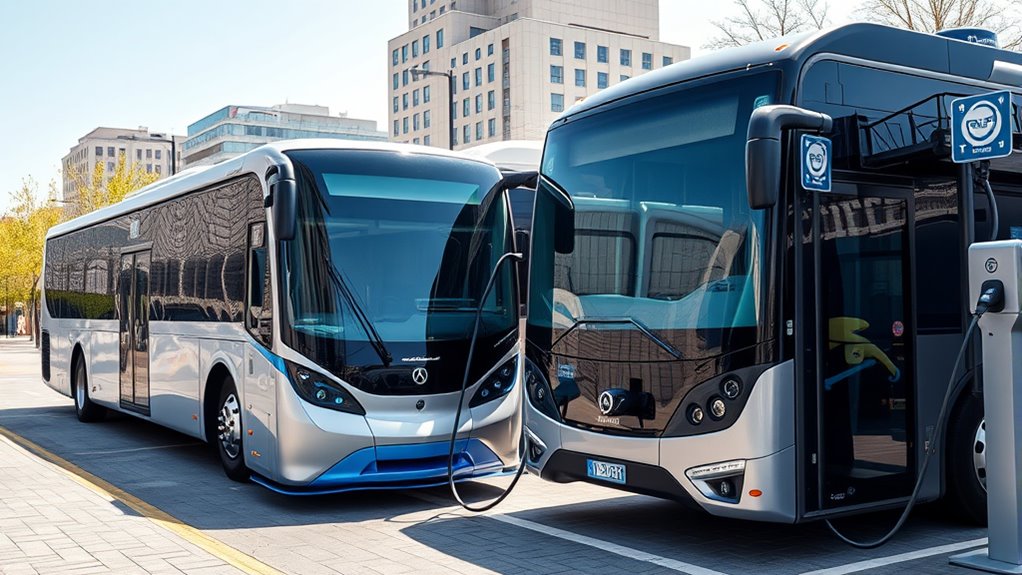
Have you noticed more electric buses on city streets? These vehicles are transforming urban transit by offering cleaner and quieter alternatives to traditional diesel-powered buses. Electric buses are powered by electric motors, which run on rechargeable batteries. They come in various types, each designed to meet different operational needs and infrastructure capabilities.
Electric buses are transforming city transit with cleaner, quieter, and more sustainable transportation options.
The most common type is the battery-electric bus. It relies solely on rechargeable batteries to power the electric motor. These buses typically have a range of several hundred miles per charge, making them well-suited for urban routes. They require charging at dedicated stations or compatible outlets, similar to electric cars. When fully charged, they produce zero emissions during operation, operate more quietly, and need less maintenance compared to conventional buses. This makes them a popular choice for city transit agencies aiming to reduce their environmental footprint.
Another variation is the plug-in hybrid electric bus. This type combines a battery with a small internal combustion engine. It can run solely on electric power for shorter routes, then switch to the engine when additional range is needed. The batteries are recharged by plugging into outlets or charging stations. This dual system offers flexibility, allowing buses to operate efficiently on electric power while having the backup of an internal combustion engine for longer routes. Additionally, advancements in battery chemistries like lithium-ion have improved performance and cost-effectiveness, further supporting their adoption. Modern charging infrastructure has also made it easier to support these hybrid systems in urban areas. Incorporating advanced battery technology can further enhance the range and efficiency of these buses.
Fuel cell electric buses take a different approach by using hydrogen fuel cells to generate electricity. These buses often include small batteries or supercapacitors as additional range extenders. Their primary benefit is quick refueling—similar to traditional fuel stops—and longer range, making them suitable for longer routes. They produce only water and heat as emissions, making them environmentally friendly. Moreover, hydrogen fuel cells are considered a promising renewable energy technology since hydrogen can be produced from renewable sources, further reducing their environmental impact.
However, they require specialized hydrogen refueling stations, which can be a challenge to develop and maintain.
All these types depend on advanced electric motors, modern battery chemistries like lithium-ion, and specific charging infrastructure. They incorporate safety features such as collision avoidance systems and are generally more cost-effective over the long term, despite higher initial investments.
Environmentally, electric buses markedly cut greenhouse gases, improve urban air quality, and reduce noise pollution. When powered by renewable energy, they become even more sustainable.
Frequently Asked Questions
What Is the Average Lifespan of an Electric Bus?
The current question asks about the average lifespan of an electric bus. You’ll find that most electric buses last around 12 to 15 years, similar to diesel buses.
Your experience may vary depending on how well you maintain the vehicle, operational conditions, and advances in battery technology.
Proper upkeep can help you maximize the lifespan, but be aware that battery degradation and mechanical issues might reduce it over time.
How Do Electric Buses Perform in Extreme Weather Conditions?
Imagine an electric bus battling a storm—its performance dips like a boat against rough waves.
In cold weather, your bus’s range drops by about 33%, and batteries lose efficiency, but proper maintenance and route planning help.
Hot weather challenges the cooling system, slightly reducing efficiency.
Still, with advanced technology and strategic adjustments, your electric bus can handle extreme conditions, ensuring reliable service even when Mother Nature tests it.
Are Electric Buses More Cost-Effective Than Diesel Buses Long-Term?
You wonder if electric buses are more cost-effective long-term. The answer is yes. While they’ve higher upfront costs, you save considerably on fuel and maintenance over their lifespan.
You’ll see annual savings of up to $50,000 per bus, plus benefits like lower emissions and quieter operation.
Over about five years, the savings outweigh initial investments, making electric buses a smarter financial choice in the long run.
What Are the Main Challenges in Deploying Electric Bus Infrastructure?
You’re facing several main challenges in deploying electric bus infrastructure. High power requirements demand grid upgrades, and space limitations at depots complicate station installs.
Coordinating with utilities can cause delays, especially with aging infrastructure and peak demand issues.
Operationally, battery range variability and charging downtime affect schedules.
Financially, upfront costs and maintenance skills pose hurdles.
Additionally, integrating renewable energy and managing evolving technology create long-term planning uncertainties.
How Do Different Charging Methods Impact Bus Operation Schedules?
You should know that various charging methods influence bus schedules differently. Overnight charging requires buses to be fully charged before starting, limiting flexibility.
Opportunity and online charging allow for more adaptable routes, as buses can recharge during or between trips.
Fast and wireless charging enable quick turnaround times, supporting continuous operation.
Choosing the right method depends on your operational needs, balancing charging times with route flexibility and schedule reliability.
Conclusion
Think of electric buses as the heartbeat of a cleaner, greener city. As you explore their different types, you’re fueling a future where transportation runs smoothly like a well-oiled machine. Embracing these buses is like planting seeds for a brighter tomorrow—each one helping to clear the air and reduce noise. So, hop on this journey, and together, let’s drive toward a more sustainable world where every mile counts.
